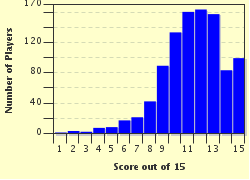Quiz Answer Key and Fun Facts
1. Mechanical engineer Whitcomb Judson developed this idea just in time for the Chicago World's Fair in 1893, but was overshadowed by the Ferris Wheel and exotic dancer 'Little Egypt'. Nowadays it's on everything from pencil cases to coats, pants, boots, backpacks and a plethora of other items. What was it?
2. The first patent issued for this item, found in stores worldwide, was back in 1952, when this item looked more like a bull's eye with concentric circles than its present-day shape. Joseph Woodland and Bernard Silver are credited with inventing what item?
3. As early as 1820, a French metallurgist named L. Bertheier worked on a type of metal that would be the savior in kitchens world wide, but it wasn't until 1920 that the first type of this cutlery was commercially sold in Meridian, Connecticut. What was it?
4. In December of 1886, Mrs. Josephine Cochrane of Shelbyville, Illinois patented the first of these after being fed up with the kitchen staff constantly breaking her good china. What was the invention called?
5. Robert Chesebrough of Brooklyn, New York owned a failing kerosene business when he accidentally discovered a waxy residue that clung to oil rigs in Pennsylvania in 1879. What did he eventually unleash upon the world?
6. Dr. Benjamin Green was a doctor who helped the U.S. military devise ways to keep soldiers from getting sunburned in the Pacific theater of World War II. His early concoction of 'red petrolatum' soon took on a white form with a scent of jasmine. He took the concoction to start a business under what name?
7. There has been some form in use since the time of the ancient Egyptians, but the man who made it popular in the U.S. in the 1930s was a balding Massachusetts volunteer fireman named John Breck. What was the product?
8. Charles Goodyear's process to vulcanize rubber in the 1860s was the impetus for this later invention. The first of these to come off the assembly line in 1917 had a black bottom covered by brown canvas. What were these items?
9. Acetylsalicylic acid, derived from the bark of the willow tree, was first discovered at the University of Montpellier in 1853, then forgotten for the next 40 years. In 1893, German chemist Felix Hoffman discovered this product could do what?
10. On May 15, 1940, this long-awaited material surfaced for the first time for commercial use, which caused long lines, near riots and a virtual end to the silk market. What was the material?
11. This piece of footwear magic was invented by a Belgian musical instrument maker named Joseph Merlin in 1759 for a costume party. What was it?
12. What candy staple is widely said to have been introduced to the U.S. by Mexican general and dictator Antonio Lopez de Santa Anna?
13. It was in 1957 Walter Frederick Morrison of California took his obsession with UFOs to create what popular childrens toy?
14. It was in 1951 that a divorced bank secretary named Bette Nesmith Graham found a way to use a form of white tempera paint to go over typewriting mistakes (the original formula was mixed with a blender). Originally called 'Mistake-Out', under what name is it better known?
15. The first person to approach this idea was Leonardo Da Vinci, but the first operational model wasn't perfected until 1877 by Swiss physician Dr. A.E. Fick. Since then, they have become the savior of the vain and the sight-impaired. What is it?
Source: Author
Oddball
This quiz was reviewed by FunTrivia editor
Exit10 before going online.
Any errors found in FunTrivia content are routinely corrected through our feedback system.


